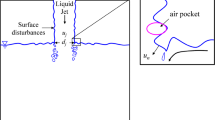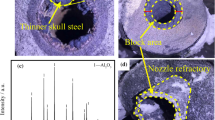Abstract
While the filling stage has the least time during the metal casting process, its influence on the casting quality can be remarkable. In gravity casting, the design and dimensions of the filling system determine the filling rate, metal velocity, and the possibility of surface turbulence, where the reliability of casting is mainly impressed by these parameters. In this study, finding an appropriate filling system for a hollow cylinder is examined by investigating the effect of the ingate size, shape, and geometry on the flow characteristics of the molten metal. Simulations are performed investigating the initial filling stages and their repercussions. Three different bottom-gating filling systems are proposed with rectangular, fan, and ring ingate shapes. To compare the filling pattern, metal velocity, and air entrainment of three different filling systems, ProCAST, a CFD simulation software, is used. Results indicated that fan ingate shape successfully introduced less turbulent flow than rectangular ingate shape, causing a reduction in air entrainment. Moreover, results showed that using ring ingate, with sufficient total ingate cross section and taking advantage of the uphill metal flow, can reduce metal velocity entering the cavity as well as eliminate air entrainment.















Similar content being viewed by others
References
J. Campbell, Complete Casting Handbook Metal Casting Processes, Metallurgy, Techniques and Design (Butterworth-Heinemann, Oxford, 2015)
X. Yang, X. Huang, X. Dai, J. Campbell, J. Tatler, Numerical modelling of entrainment of oxide film defects in filling of aluminium alloy castings. Int. J. Cast Met. Res. 17(6), 321–331 (2004)
X. Dai, X. Yang, J. Campbell, J. Wood, Influence of oxide film defects generated in filling on mechanical strength of aluminium alloy castings. Mater. Sci. Technol. 20, 505–513 (2004)
J. Campbell, Entrainment defects. Mater. Sci. Technol. 22, 127–145 (2006)
D.Z. Li, J. Campbell, Y.Y. Li, Filling system for investment cast Ni-base turbine blades. J. Mater. Process. Technol. 148(3), 310–316 (2004)
M. Cox, M. Wickins, J.P. Kuang, R.A. Harding, J. Campbell, Effect of top and bottom filling on reliability of investment castings in Al, Fe, and Ni based alloys. Mater. Sci. Technol. 16(11–12), 1445–1452 (2000)
R. Dojka, J. Jezierski, J. Campbell, Optimized gating system for steel castings. J. Mater. Eng. Perform. 27(10), 5152–5163 (2018)
J. Campbell, Sixty years of casting research. Metall. Mater. Trans. A 46(11), 4848–4853 (2015)
J. Runyoro, S. Boutorabi, J. Campbell, Critical gate velocities for film-forming casting alloys: a basis for process specification. AFS Trans. 37, 225–234 (1992)
C. Lyu, M. Papanikolaou, M. Jolly, Numerical process modelling and simulation of campbell running systems designs, in: Shape Casting, pp. 53–64 (2019)
M. Brůna, I. Vasková, M. Galčík, Numerical simulation and experimental validation of melt flow in the naturally pressurized gating system. Processes 9(11), 1931 (2021)
R. Lett, S. Felicelli, J. Berry, R. Cuesta, A. Rivas, M.E. Alcalde, Quality aspects of A356 castings with multiple gates. Int. Metalcast. 6, 67–82 (2012). https://doi.org/10.1007/BF03355528
B. Sirrell, M. Holliday, J. Campbell, Benchmark testing the flow and solidification modeling of Al castings. JOM 48(3), 20–23 (1996)
S. Skov-Hansen, N.S. Tiedje, Reduced energy consumption by using streamlined gating systems, in: China Foundry Association Congress, Shanghai (2008)
J. Campbell, Casting Practice: The 10 Rules (Butterworths/Heinemann, London, 2004)
J. Campbell, Stop pouring, start casting. Int. Metalcast. 6, 7–18 (2012). https://doi.org/10.1007/BF03355529
B. Sirrell, J. Campbell, Mechanism of filtration in reduction of casting defects due to surface turbulence during mold filling. AFS Trans. 105, 645–654 (1997)
M. Jolly, H. Lo , M. Turan, J. Campbell, X. Yang, Development of Practical Quiescent Running Systems Without Foam Filters for Use in Aluminium Castings Using Computer Modelling, in: Modeling of casting, welding and advanced solidification Processes, pp. 319-325 (2001)
H. Hashemi, R. Raiszadeh, Naturally-pressurized running systems: the role of ceramic filters. J. Appl. Sci. 9(11), 2115–2122 (2009)
F.Y. Hsu, C.L. Li, Runner systems containing ceramic foam filters quantified by “area normalized” bifilm index map. Int. Metalcast. 9, 23–35 (2015). https://doi.org/10.1007/BF03355620
K. Metzloff, K. Mageza, D. Sekotlong, Velocity measurement and verification with modeling of naturally pressurized gating systems. Int. Metalcast. 14, 610–621 (2020). https://doi.org/10.1007/s40962-020-00471-w
T. Din, R. Kendrick, J. Campbell, Direct filtration of A 356 Al alloy. AFS Trans. 111, 91–100 (2003)
F.Y. Hsu, C.L. Li, J. Campbell, Ceramic foam filters in runner system design for castings. Key Eng. Mater. 573, 19–29 (2014)
A. Baghani, A. Kheirabi, A. Bahmani, H. Khalilpour, Reducing Melt Surface Turbulence by Employing Surge and Filter in a Conventional Non-Pressurizing Gating System: Simulation and Experiment, Arch. Metall. Mater. 66(2), 397-405 (2021). https://doi.org/10.24425/amm.2021.135871
R. Stebbins, P. King, G. Manogharan, A computational study in novel runner extension designs via 3d sand-printing to improve casting performance, in: International Manufacturing Science and Engineering Conference (2021)
M. Papanikolaou, E. Pagone, M. Jolly, K. Salonitis, Numerical simulation and evaluation of campbell running and gating systems. Metals 10(1), 68 (2020)
F. Hsu, M. Jolly, J. Campbell, Vortex-gate design for gravity casting. Int. J. Cast Met. Res. 19(1), 38–44 (2006)
H.-J. Lin, F.-Y. Hsu, A diffusing runner for gravity casting. Metall. Mater. Trans. B 40(6), 833–842 (2009)
C.D. Ridgeway, K. Ripplinger, D. Detwiler, A.A. Luo, Prediction of entrained oxide inclusions and oxide induced defects during directional flow in aluminum casting. AFS Trans. 128, 59–70 (2020)
M. Divandari, J. Campbell, Mechanisms of bubble trail formation in castings. AFS Trans. 109, 433–442 (2001)
M. Divandari, Mechanisms of bubble damage in castings, University of Birmingham: Doctoral dissertation (2001)
M.A. El-Sayed, K. Essa, H. Hassanin, Effect of runner thickness and hydrogen content on the mechanical properties of A356 alloy castings. Int. Metalcast. (2022). https://doi.org/10.1007/s40962-021-00753-x
J. Campbell, Materials perspective entrainment defects. Mater. Sci. Technol. 22(2), 127–145 (2006)
P. Yousefian, M. Tiryakioğlu, Pore formation during solidification of aluminum: reconciliation of experimental observations, modeling assumptions, and classical nucleation theory. Metall. Mater. Trans. A 49(2), 563–575 (2018)
G. Gyarmati, G. Fegyverneki, M. Tokár, T. Mende, Investigation on double oxide film initiated pore formation in aluminum casting alloys. Int. J. Eng. Manag. Sci. 15(2), 141–153 (2020)
S.H. Majidi, C. Beckermann, Effect of pouring conditions and gating system design on air entrainment during mold filling. Int. J. Metalcast. 13(2), 255–272 (2019). https://doi.org/10.1007/s40962-018-0272-x5-272
M. Itamura, K. Murakami, T. Harada, M. Tanaka, N. Yamamoto, Effect of runner design on metal flow into cavity. Int. J. Cast Met. Res. 15(3), 167–172 (2003)
M. Divandari, J. Campbell, A new technique for the study of aluminum oxide films. Alum. Trans. 2(2), 233–238 (2000)
M. Divandari, J. Campbell, Morphology of oxide films of Al–5mg alloy in dynamic conditions in casting. Int. J. Cast Met. Res. 18(3), 187–192 (2005)
Y. Yang, Modelling of the effects of entrainment defects on mechanical properties in Al-Si-Mg alloy castings, University of Birmingham: Doctoral dissertation, 2014.
D. Rafał, J. Jezierski, M. Szucki, The importance of the geometry of the down sprue in the gravity casting process. Materials 15, 4937 (2022)
N. Tiedje, P. Larsen, Investigation of the stability of melt flow in gating systems. Metall. Mater. Trans. B. 42(1), 189–201 (2011)
A. Baghani, A. Bahmani, P. Davami, N. Varahram, M. Shabani, Numerical investigation of the effect of sprue base design on the flow pattern of aluminum gravity casting. Defect Diffus. Forum 344, 43–53 (2013)
R. Dojka, J. Jezierski, N.S. Tiedje, Geometric form of gating system elements and its influence on the initial filling phase. J. Mater. Eng. Perform. 28(7), 3922–3928 (2019)
K.H. Renukananda, B. Ravi, Multi-gate systems in casting process: comparative study of liquid metal and water flow. Mater. Manuf. Process. 31(8), 1091–1101 (2016)
Funding
No funding was received for conducting this study.
Author information
Authors and Affiliations
Corresponding author
Ethics declarations
Conflict of interest
The authors have no financial or proprietary interests in any material discussed in this article.
Additional information
Publisher's Note
Springer Nature remains neutral with regard to jurisdictional claims in published maps and institutional affiliations.
Appendix 1: Simulation Validation (This Part was Added by the Editor’s Recommendation)
Appendix 1: Simulation Validation (This Part was Added by the Editor’s Recommendation)
This model does not have experimental validation. However, the authors had done some validation on the simulation software (ProCAST) before the current model. The Sirrell and Campbell13 benchmark test and Renukananda and Ravi45 multi-gate test were used for fluid flow validation. Figure
16a, b shows the benchmark test and multi-gate system sketch in the validation.
Figures 17 and 18 represent the simulation result of these two tests. As is apparent in Figures 17 and 18, simulation results showed a similar pattern for mold filling in both benchmark and multi-gate system tests.
Real-time X-ray unit for comparing the progressive filling of the mold13—simulation results of the filling of the mold.
(a) Total volume of flow,45 (b) simulation results of total volume flow.
Rights and permissions
Springer Nature or its licensor (e.g. a society or other partner) holds exclusive rights to this article under a publishing agreement with the author(s) or other rightsholder(s); author self-archiving of the accepted manuscript version of this article is solely governed by the terms of such publishing agreement and applicable law.
About this article
Cite this article
Moradi, A., Divandari, M. Effect of Bottom Gating Filling System Design on the Initial Stage of Mold Filling: A Parametric Study. Inter Metalcast 17, 2716–2730 (2023). https://doi.org/10.1007/s40962-022-00937-z
Received:
Accepted:
Published:
Issue Date:
DOI: https://doi.org/10.1007/s40962-022-00937-z







